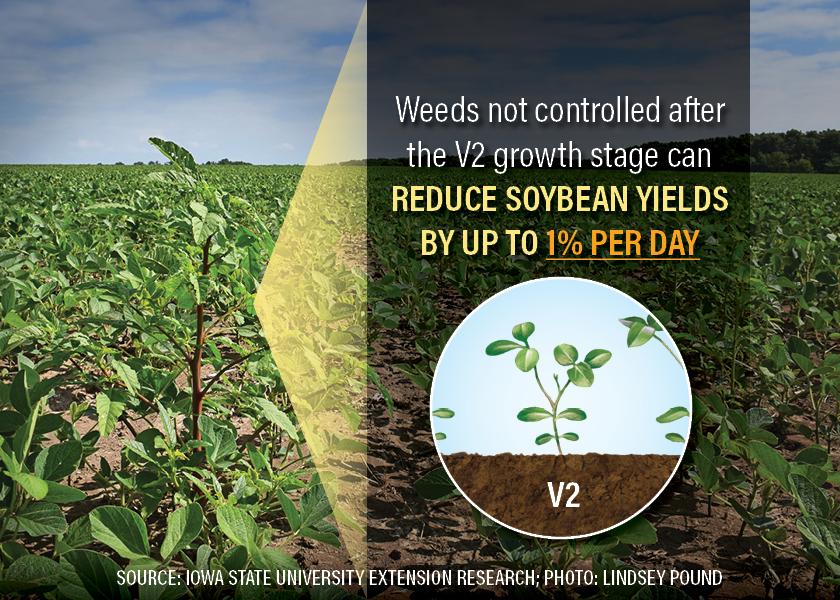7 Steps to Better Post-Herbicide Weed Control In Soybeans

If your weed-control program in soybeans needs more attention this season, you’re not alone. Hot, dry conditions hampered early-season broadleaf and grass control measures across much of the Midwest.
The thing to do now is to determine your best next steps. There are several reasons why you might want to take additional control measures, if your preemergence or first post-herbicide application performed poorly. The obvious reason is to prevent yield loss.
Iowa State University Extension research shows weeds not controlled after the V2 growth stage can reduce soybean yields by up to 1% per day. You read that right – a 1% yield reduction per day. Furthermore, uncontrolled weeds can contribute to harvest difficulties and weed seed banks, with the latter continuing to spawn weeds in subsequent years.
Here are seven steps to help you now:
1. Determine your post-herbicide application options. Consider pairing a residual herbicide with a post-emergence herbicide in the tank. Many broadleaf weeds, such as waterhemp and Palmer amaranth, emerge throughout the growing season and can be better controlled with layered herbicide applications, according to Liam Vincent, technical marketing manager for BASF.
“Trust your residual in addition to the post herbicide to extend the control of tough broadleaf weeds,” he says.
2. Consider making the application in morning or evening. High temperatures cause weeds to droop and their leaves to roll up, which can prevent good spray coverage, according to Joe Ikley, Debalin Sarangi, Tom Peters, and Dave Nicolai, University of Minnesota Extension specialists.
“Spraying in the morning or evening will also help with coverage on weeds in hot dry conditions. In general, applying systemic herbicides early in the morning, after plants have had a chance to recover from heat stress, will give the best chance for the herbicide to reach the active site and effectively kill weeds,” they write. Learn more here.
3. Beware of herbicide volatility. Some active ingredients are more prone to drift in high temperatures. Make sure you follow label directions to prevent the potential occurrence of off-target movement. Along with that, consider using coarser droplets to minimize evaporation.
4. Include an adjuvant. Use recommended adjuvants at labeled rates to help spray droplets absorb better into leaf surfaces. An adjuvant helps dissolve cuticles and slow evaporation rates, especially important in hot, dry conditions.
5. Evaluate spray volume. Check herbicide labels to see how much water you can use in the tank to increase spray volume, which can improve weed coverage and control. Some contact herbicides with limited translocation need at least 10 to 15 gallons of water per acre in the tank for adequate weed coverage. If you have dense weed pressure, you’ll need more water in the tank. Don't skimp.
6. Check fields after applications. Scout fields within a week to 10 days after a postemergence application to evaluate control, encourages BASF’s Vincent. This will give you time to consider next steps if what you see is less than satisfactory control.
7. Consider pulling the worst yield robbers by hand. No one wants to hand hoe or pay a crew to pull weeds, but it could be necessary as some weed seeds are viable for years. University of Minnesota research shows over 50% of lambsquarters seeds can be viable in 12 years. For waterhemp, 50% of the viable seeds will be degraded in three years. Giant ragweed seeds are degraded relatively quickly, with over 95% of the weed seeds being degraded in two years (Goplen et al. 2017).
4 Sprayer Tricks to Keep Your Rig Rolling
Ferrie: Year of the Waterhemp is Underway
Are You Spraying The Right Weeds? Apps Can Help
3 Tips For Better Weed-Control Outcomes this Season
Does Electrocuting Herbicide-Resistant Weeds Really Work? This Weed Scientist Now Has Proof
Hit the Weed Window or Pay a Price







